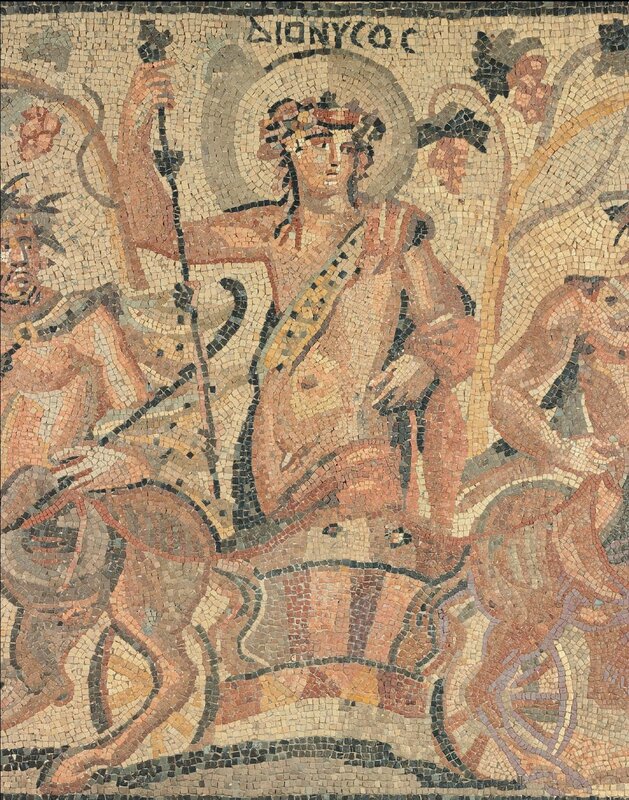A Roman stone mosaic panel, circa 3rd century A.D.
Lot 9. A Roman stone mosaic panel, circa 3rd century A.D. Estimate $200,000 - $300,000. Price Realized $545,000. Photo Christie's Image Ltd 2016.
Composed of multicolored tesserae on a cream ground, with Dionysus riding in a chariot pulled by two rearing centaurs, the left bearded, the right youthful, the god nimbate, depicted nude but for an animal skin draped diagonally across his chest from his left shoulder, a mantle draped on top and over his arm, a thyrsus in his raised right hand, a crown of ivy and berries in his hair, an identifying Greek inscription above his head, the centaurs each with an animal skin tied over his shoulders and holding a lagobolon, fruit-bearing vines in the field, enclosed within a black frame; 49 ½ in. x 65 ½ in. (125.7 cm. x 166.3 cm.)
Provenance: Private Collection, U.S.
An American Private Collector; Antiquities, Sotheby's, New York, 17 December 1998, lot 182.
with Royal-Athena Galleries, New York, acquired from the above.
Acquired by the current owner from the above, 2000.
Note: K.M.D. Dunbabin urges modern viewers to consider mosaics within the context of their functional role as integral architectural elements in Roman buildings. She goes on to note that the majority of mosaics known to current scholars come from the floors and walls of dining rooms (trinclinia) in Roman homes (Mosaics of the Greek and Roman World, pp. 1-6). When framed in such a context, this mosaic featuring Dionysus, the god of wine, becomes more than just an isolated mythological scene and rather an instance of a union between a subject matter and its physical location. The particular subject here with Dionysus in a chariot pulled by centaurs is a popular scene in the Imperial period. A mosaic with the same subject is in the permanent collection of the Bardo Museum, Tunisia. The subject was also popular in other media; see for example a large cameo in the Louvre, no. 216 in C. Gasparri, "Dionysos/Bacchus," in LIMC, vol. III.
Christie's. ANTIQUITIES, 12 April 2016, New York, Rockefeller Plaza

/https%3A%2F%2Fprofilepics.canalblog.com%2Fprofilepics%2F1%2F0%2F100183.jpg)
/https%3A%2F%2Fstorage.canalblog.com%2F03%2F02%2F119589%2F96711876_o.jpg)
/https%3A%2F%2Fstorage.canalblog.com%2F11%2F31%2F119589%2F94773502_o.jpg)
/https%3A%2F%2Fstorage.canalblog.com%2F20%2F83%2F119589%2F94772815_o.jpg)
/https%3A%2F%2Fstorage.canalblog.com%2F26%2F72%2F119589%2F75604929_o.jpg)
/https%3A%2F%2Fstorage.canalblog.com%2F59%2F60%2F119589%2F26458628_o.jpg)




/http%3A%2F%2Fstorage.canalblog.com%2F58%2F84%2F119589%2F129560262_o.jpg)
/http%3A%2F%2Fstorage.canalblog.com%2F31%2F36%2F119589%2F127772045_o.jpg)
/http%3A%2F%2Fstorage.canalblog.com%2F62%2F22%2F119589%2F122451290_o.jpg)
/http%3A%2F%2Fstorage.canalblog.com%2F18%2F49%2F119589%2F122383911_o.jpg)